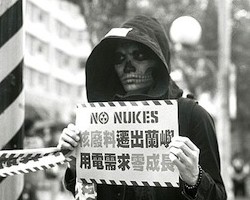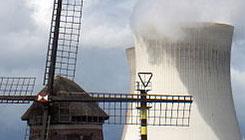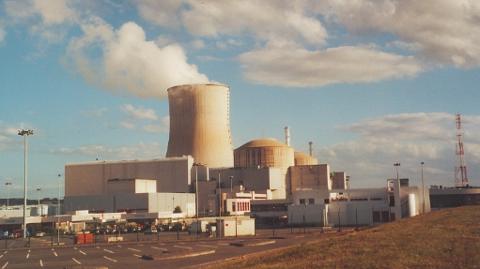While President Obama has put climate change back on the national agenda, the likelihood of significant action is low. Earth continues its resolute march toward global warming, the results of which continue to be born out in every storm, drought and species die-off. A chorus of experts has offered up everything from energy credits, carbon caps, taxes and social engineering to address the crisis, but so far we’ve only continued to shove our heads further into the increasingly hot sand. There are a solutions, though, and one of them could come in the form of nuclear energy. Despite the fact that it’s been a part of presidential energy policies from both parties, it remains outrageously controversial, and support of new nuclear plants still means political blow back.
The next generation of nuclear power
However, a new breed of nuclear-power facilities, which bear little resemblance to their forerunners, is finding support among a most unlikely group, including leading environmentalists Stewart Brand, Mark Lynas, Michael Schellenberger, James Hanson and anti-nuke documentary filmmaker Robert Stone. Stone’s pro-nuclear energy documentary
Pandora’s Promise has generated far more thoughtful conversation than controversy. (Disclosure: I was hired by an indie PR firm to do some press for four films at the 2013 Sundance Film Festival, including
Pandora’s Promise. I was entirely anti-nuke prior to seeing the film and have had no contact with the project since the festival ended.) The fervor of these supporters is due to the fact that modern nuclear technology is the most reasonable, measured approach for not only reducing the carbon footprint in big consumer countries, but also cheaply and safely generating power in the places that need it the most: developing nations. There are formidable roadblocks to creating a new nuclear energy paradigm, beginning with the term itself. "Nuclear" breeds a gut reaction and reporting about the few disasters that have happened, is nearly always lacking in critical information about the nature of the accidents, as well as the technology of the facilities themselves and the countries in which they were built.
Fear is a powerful obstruction

Chernobyl — that non-compliant, poorly constructed Soviet death trap — casts a long shadow. Japan's tidal-wave-pounded Fukushima Daiichi is vexing, and now it's been widely reported that underground tanks at the Hanford Nuclear Reservation are threatening to explode. If that doesn’t paint a bleak enough picture, instability throughout the world generates dread that uranium used in existing plants will create a proliferation of nuclear weapons-grade materials. Despite the grimness of the media reports, the truth is far more nuanced. Each nuclear situation comes with its own set of challenges. As to what happens post-disaster, Chernobyl probably provides the best window: After nearly 30 years of research, the Ukrainian plant's meltdown has proven to be nowhere near as deadly as previously thought and a predicted generation of horrifying cancer clusters has never materialized. A door to debate and discussion without inflammatory rhetoric needs to be opened.
Renewables are only part of the answer
For those of you that cling to the hope of solar and wind power as the answer, while pointing at Germany as the ultimate solar success story, it may be wise to loosen your grip. While an impressive 22 percent of Germany’s power is generated with renewables, (in the U.S. it's only 3.6 percent), solar power provides less than a quarter of it. Wind and sun are intermittent and variable resources, with a need for large collecting areas. There's a lack of adequate storage materials, which creates waste heat. Most importantly, we aren’t close to finding a way to store and then transmit anywhere near enough energy for long nights and gray, windless days.
The curse of particulates
Meanwhile, particulate matter from fossil fuels continues to be a primary killer. Decades of medical and environmental research draw a direct link from outdoor air pollution to an early demise. According to a fine-tuned, comparative risk assessment of worldwide causes of death published in The Lancet in 2012, fine particulate matter — such as soot — contributes to more than 3.2 million deaths each year. Our use of coal, a major particulate creator, has only increased. The World Coal Association states that coal in all its forms “provides 30.3 percent of global primary energy needs and generates 42 percent of the world’s electricity,” and is the “fastest growing form of energy outside of renewables.” And while the U.S. and China are major coal users and producers, even green Germany is one of the top 10 countries that use coal to produce electricity, and is itself a major producer of lignite.
Generation III nuclear power snapshot
Third-generation nuclear power plants have been operating in Japan since 1996 (Fukushima Daiichi was built in the 1960s). France is currently operating third-generation plants and despite opposition, Britain is pressing forward in building new facilities. The short story is that they are smaller, have a simpler, sturdier, standardized design, a longer operating life and use fuel far more efficiently, thus reducing the amount of waste. They also provide for a three-day period where no active intervention is required following any kind of shut-down and incorporate “passive or inherent” safety features that require little or no human intervention to avoid accidents in the event of malfunction.
Generation IV nuclear power snapshot
Pressing forward, here’s how the near future may look: six different categories of thermal reactors, molten salt reactors and gas-cooled fast reactors. These nuclear technologies have clear advantages over what exists now. The plants are even smaller in size, use less uranium and can potentially yield 100 to 300 times more energy. They have vastly improved operating safety. They recycle nearly all of their existing nuclear waste in the production of electricity, and the small amount of waste that does remain is radioactive for centuries not millennia. The bottom line is, we need to pave the way for a less rigid brand of international environmentalism that isn’t afraid to consider new versions of nuclear technologies. That’s not to say that we shouldn’t regard the risks, of which there are many. New technologies, nuclear and otherwise, come with bumps and it’s impossible for every conceivable contingency to be covered in simulations. Also, human error is always a factor. But we have to press on, continue to test the possibilities and sort out deficiencies. It may be time to stop chanting “No Nukes,” at least where creating energy is concerned. We aren't going to blow up or glow. We just need another link in the chain to arrest global warming. Image: Wikimedia Commons
 Chernobyl — that non-compliant, poorly constructed Soviet death trap — casts a long shadow. Japan's tidal-wave-pounded Fukushima Daiichi is vexing, and now it's been widely reported that underground tanks at the Hanford Nuclear Reservation are threatening to explode. If that doesn’t paint a bleak enough picture, instability throughout the world generates dread that uranium used in existing plants will create a proliferation of nuclear weapons-grade materials. Despite the grimness of the media reports, the truth is far more nuanced. Each nuclear situation comes with its own set of challenges. As to what happens post-disaster, Chernobyl probably provides the best window: After nearly 30 years of research, the Ukrainian plant's meltdown has proven to be nowhere near as deadly as previously thought and a predicted generation of horrifying cancer clusters has never materialized. A door to debate and discussion without inflammatory rhetoric needs to be opened.
Chernobyl — that non-compliant, poorly constructed Soviet death trap — casts a long shadow. Japan's tidal-wave-pounded Fukushima Daiichi is vexing, and now it's been widely reported that underground tanks at the Hanford Nuclear Reservation are threatening to explode. If that doesn’t paint a bleak enough picture, instability throughout the world generates dread that uranium used in existing plants will create a proliferation of nuclear weapons-grade materials. Despite the grimness of the media reports, the truth is far more nuanced. Each nuclear situation comes with its own set of challenges. As to what happens post-disaster, Chernobyl probably provides the best window: After nearly 30 years of research, the Ukrainian plant's meltdown has proven to be nowhere near as deadly as previously thought and a predicted generation of horrifying cancer clusters has never materialized. A door to debate and discussion without inflammatory rhetoric needs to be opened.

